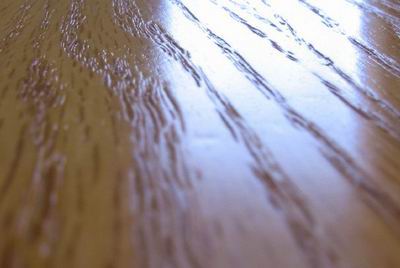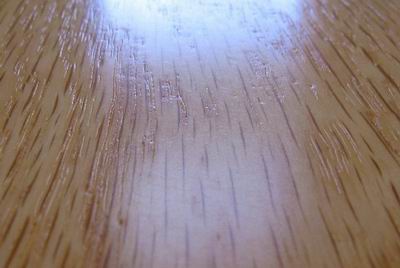Filling Depressions Exposed by Topcoats
Sprayers share tips for achieving a flat, filled, fine finish. January 25, 2005
Question
I am working on a tabletop that is veneered partly with ash. The ash has a fairly deep grain. After three coats of nitro lacquer, certain grain and joints seem to be getting deeper as the finish builds around them. I don't mind seeing grain, but when you look across the top, there are a few spots that are too deep. I was thinking of possibly adding a retarder to the finish to let it flow out a little better. Or is there some kind of clear fill that I could put in the deeper recesses? Is there another way that would be better?
Forum Responses
(Finishing Forum)
From Paul Snyder, forum technical advisor:
The finish keeps building higher on the areas surrounding the pores/gaps as you apply more coats, but the recesses look deeper and deeper. With the standard 2-3 coats of finish, you get an open pore look like the oak board in this picture.

To get a semi-filled pore look, you need to sand the finish back aggressively before applying another coat. I usually like to use a sealer for this process, but you can use the finish itself. In the picture below, I applied a couple coats of sealer and sanded each one back before applying the next coat. Then I sprayed a couple coats of lacquer per usual.

Adding retarder won't make the lacquer fill the pores any better than it has. Sanding the lacquer back and re-spraying is the technique I'd use.
From contributor J:
You could also make some fat lacquer (lacquer left open until it thickens), then use it to fill the grain. After it dries, sand it flush and spray another coat.
From contributor D:
In theory, contributor J has the right approach for filling a couple pitch pockets or something similar. But you would be filling the grain for a week with this method. Do as Paul suggests. Take a straight line sander and be very aggressive with 240-280 paper. Then thin your next 1 or 2 coats about 15%.
From contributor R:
I didn't see what coating you are using and something to consider here is dry film thickness. Sanding back the high spots still leaves a heavy coating in the grain, which could cause problems with some coatings. I prefer a paste filler or a high build sealer to fill the grain that doesn't have strict dry film limitations.
From the original questioner:
I have been sanding back and applying more coats and my finish is close to Paul's second photo, with the exception of a couple of spots where I might try contributor J's idea. Also, I am using MLC Magnalac Satin, but after a few coats it gets glossier than I want.
From contributor B:
The problem is surface tension between your lacquer and the oak. Like water on a waxed surface, it doesn't want to flow into the grain of the wood. Add some smoothie (silicone) or some slow thinners or retarders. The silicone will definitely reduce the tension in the coating.
From contributor E:
Ash, being an open pored wood, should not be filled with lacquer. Over time - it may take a year or two - you'll start seeing cracks all over the top right where the grain is. It will look very bad.
My advice: strip the table. Use a paste filler or a coating such as 2 component polyurethane or polyester to fill the grain. Anyone else agree?
From contributor B:
Contributor E is correct on this, although polyesters will exhibit the same failure because of their inflexibility. Read manufacturer's specs for mil requirements.
From contributor E:
Really? I always thought you can build polyester to fill anything, although I've never experimented with it.
From contributor J:
What is the name brand of polyester grain filler and where can I get it?
From Paul Snyder, forum technical advisor:
For a semi-filled pore look, I've been using the sand back method for a long time and have never received a callback for finish failure (e.g., cracking). And I've used the technique on both water-base and solvent base finishes. As long as the overall dry film thickness is below the manufacturer's recommended limit, I haven't had any problems.
Sanding back is not a good technique to use for a full-filled finish unless the sealer/finish is not prone to shrinking after it's been leveled. Catalyzed sealers, including polyester, are a good choice when you want to avoid shrinkage. Just give it time to cure before you sand it back. Non-catalyzed sealers and finishes will continue to shrink over a period of months and the pores will reappear in the surface of the finish as dimples. In some cases, the entire grain structure of the wood will become clearly visible in the surface of the finish if it shrinks enough as it cures.
From contributor A:
Er... ah... am I missing something here, gang? For all open pore woods - oak, ash, etc. - we always use a grain filler before any clears.
From contributor B:
No, you're not missing anything. The use of a filler to match grain color is the least time- and dollar-consuming way to go. Nowadays, they even make a clear filler that spreads and fills oak so you don't have to put so much labor into a full filled finish. Technology… what a wonderful thing!
From Paul Snyder, forum technical advisor:
If you need a full-filled finish, then a pore filler is a good choice. It just depends on the nature of the work.
From the original questioner:
I was not actually looking for a full-filled finish. Just consistency. A couple of spots are too deep and they stand out too much. I am looking into the Crystalac - seems like a good solution. I am hoping that I can spot apply it over my NC and then spray another coat of NC over the whole piece.
From contributor I:
Just what kind of product is Crystalac? You don't want to use anything that's not compatible.
From Paul Snyder, forum technical advisor:
I was thinking the same thing as contributor I. The water-base grain filler (Crystalac) may buckle or wrinkle if you use a solvent lacquer over it.
Depending on the reason for the depressions and how deep they are, you may be able to just use some lacquer to drop fill them and then level them.
From contributor R:
It sounds to me like you just went a little too far with the fill. You are in that twilight zone between an open pore finish and full closed coat finish that can be difficult to achieve with a very open pore wood like oak or ash. The problem is that some of the pores are much deeper than others and you get an uneven look. The more you try and spray additional topcoat, the worse it looks until you achieve full fill, and then it shrinks back. I try and sell clients on more of an open pore look on these wood species, or else go all out and get the full closed coat look. This may not help you now, but can be a red flag in the future.
The comments below were added after this Forum discussion was archived as a Knowledge Base article (add your comment).
Comment from contributor H:
My experience has shown that filling the grain is the best solution. Building with lacquer won't level out enough, as each time you respray, it melts the prior coat of finish. If you desire a smooth, flat, surface, try to choose a tight-grained species of wood or board to start with.
Comment from contributor P:
I start out by staining the piece, and then seal it with the usual lacquer sealer. When it is dried, sand it with 280 or finer and then paste-wood fill the top with filler tinted with the stain you used on the piece in the first place. This takes care of the open grains without super filling it to the very smooth point, and also keeps the grain the correct color. You can top-coat after only an hour in most cases. You can also wait till the next day to be super safe, and there shouldn’t be any grain problem. The piece will have its grain, but not open grain.


